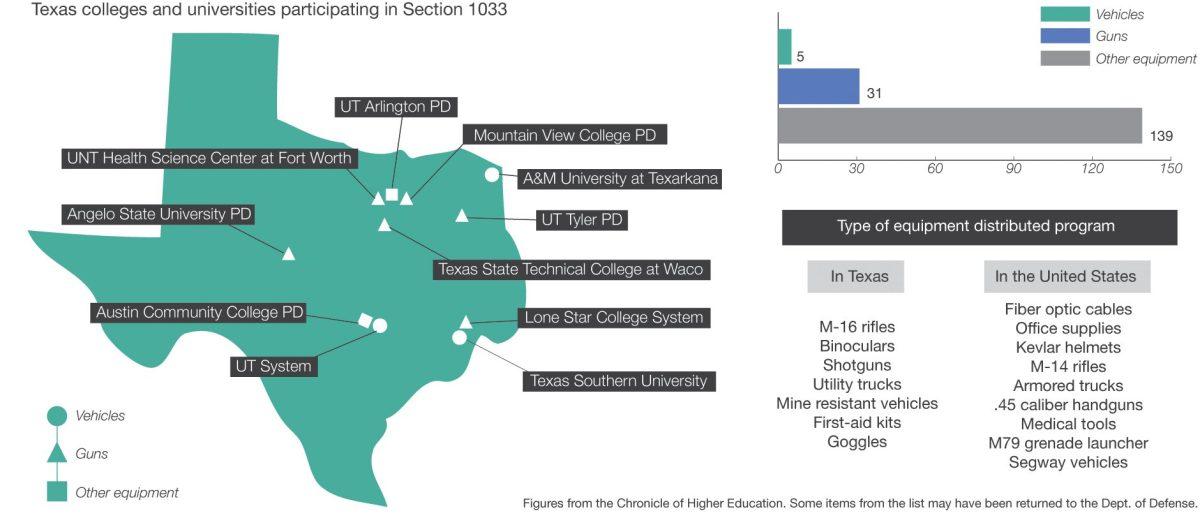A Department of Defense program giving surplus military equipment to police departments around the country has come under recent scrutiny.
City and University police departments, along with school districts across the nation have used the program, known as Section 1033, to obtain gear. This aspect in particular has come under fire, with about two dozen groups, including the NAACP, releasing a letter on Sept. 15 asking the DOD to stop issuing the equipment to schools.
More than $5.1 billion of equipment has been transferred to law enforcement officials since the program’s inception since in 1997.
UT System police departments have been able to equip themselves with hand-me-down weapons, vehicles and other equipment from the program.
Police departments tend to use the program to get equipment because it is typically less expensive for them to attain as opposed to buying from a vendor, according to UTDPD’s Chief of Police Larry Zacharias.
They also have the option of getting their equipment through catalogues sent to them from suppliers. These catalogues have everything from tactical boots to helmets, Zacharias said.
He said whether or not a police department uses the program to get equipment depends on what its goal is. UTDPD’s focus is on more of a community approach toward policing, making some of the heavier equipment nonessential, Zacharias said.
“I also feel very strongly about how we interact with the Richardson PD because of our partnership with them and the training that we’ve done with them,” Zacharias said. “So if I have a situation that goes tactical, I have the upmost confidence in how Richardson will assist us with that. So I don’t feel from my perspective that I have to have a full blown SWAT team, that I have to have assault rifles and all this tactical gear.”
He said the probability of a situation where UTDPD would need a tactical squad for assistance, such as an active shooter, is relatively low.
Zacharias said UTDPD did acquire equipment from the program, but it was disposed of before he was named chief. This gear included night goggles and an armored vehicle. To his knowledge, UTDPD is not currently in possession of any equipment from the DOD.
The UT System, on the other hand, has two Humvees and a Mine-Resistant Ambush Protected armored vehicle from the 1033 program, along with patrol rifles. Karen Adler, assistant director of public affairs for the System, said the MRAP is used in the event of an active shooter to provide protection to officers and victims. It is also used to locate survivors after a natural disaster.
The Humvees are stationed in the Rio Grande Valley, where the System’s rapid rsponse team can deploy them to protect UT Brownsville and UT Pan-American.
“Those two campuses are located near the border with Mexico, and so they would be available in the event of any kind of spillover border violence or any other event that might harm the students, faculty or staff at the campuses,” Adler said. “They’ve actually been used at each campus already in the past. One time, when somebody was threatening to explode an explosive device one time at UT Brownsville, and another situation where a student at UT Pan-American was kidnapped by a suspected drug cartel.”
Even though the intent of these vehicles is for schools to use them in situations where schools in the System are undergoing a tactical situation, the odds of them being helpful at schools like UTD are low.
“The chances of taking UT System equipment and deploying it on an active shooter or active tactical situation, the chances of it getting here in time are slim,” Zacharias said. “Particularly if this MRAP is located at the UT Academy down outside of Austin, it’s not going to get here in time to help me.”
He said one of the problems with getting such gear is the necessary training that goes along with it—time he would rather use to focus on other areas.
“I really don’t have a strong interest in pursuing the 1033 program,” he said. “I don’t want to build up a big tactical force. I’d rather my guys receive more training on how to recognize and identify a mental illness because that’s a growing concern on campus. I’d rather spend more time and money training my guys on that because that’s what we see.”





